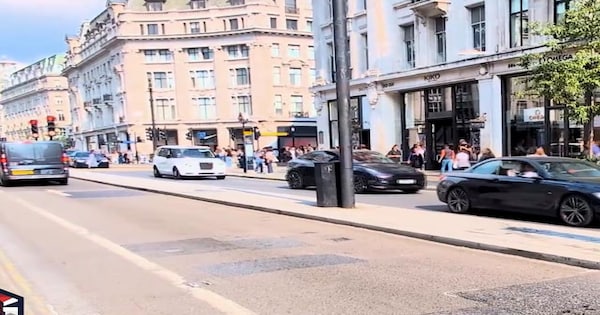– How might the transport logistics industry be affected by the traffic ban on Oxford Street?
London Mayor’s Bold Move: Traffic Ban on Oxford Street and Its Impact on the British Economy
In a groundbreaking move, the Mayor of London has announced a plan to ban traffic on Oxford Street, one of the capital’s busiest and most iconic shopping streets. This bold initiative aims to reduce air pollution, improve pedestrian safety, and create a more pleasant and inviting environment for residents and visitors.
The traffic ban on Oxford Street is set to have a significant impact on the British economy, with both positive and negative implications for businesses, consumers, and the city as a whole. In this article, we’ll explore the potential effects of the traffic ban and consider how it may reshape the economic landscape of London.
Keywords: London Mayor, traffic ban, Oxford Street, British economy, air pollution, pedestrian safety, business impact, consumer behavior
Impact on Retail Businesses
Oxford Street is home to some of the world’s most famous retail stores, attracting millions of shoppers each year. The traffic ban is expected to have a mixed impact on retail businesses, with some potential benefits and challenges:
Benefits:
– Improved pedestrian experience: With less traffic, shoppers can enjoy a more leisurely and safer shopping experience, potentially leading to increased foot traffic and sales for businesses.
– Enhanced outdoor shopping and dining: The traffic ban may create opportunities for retailers to expand their outdoor display areas and attract more customers.
Challenges:
– Delivery and logistics: Retailers will need to adapt their supply chain and delivery processes to comply with the new traffic regulations, potentially leading to increased operational costs.
– Accessibility: Businesses may face challenges in attracting customers who rely on private transportation, especially those from outside the city.
the traffic ban presents an opportunity for retail businesses to reimagine their storefronts and marketing strategies, while also adapting to the changing consumer behavior.
Impact on Tourism and Hospitality
Oxford Street is a major tourist attraction, drawing visitors from around the world. The traffic ban is likely to have a significant impact on tourism and hospitality in London:
Benefits:
– Improved visitor experience: Tourists and locals alike can enjoy a more pleasant and pedestrian-friendly environment, leading to increased tourism spending and positive reviews.
– Attractive events and street performances: The traffic-free street may create opportunities for cultural events, street markets, and entertainment, enhancing the overall visitor experience.
Challenges:
– Transportation logistics: Tour operators and travel companies may need to adjust their itineraries and transportation routes to accommodate the traffic ban, potentially leading to additional costs and logistical challenges.
– Disruption to existing businesses: Hospitality establishments may face temporary disruptions during the transition period, potentially affecting their revenue and customer satisfaction.
the traffic ban is likely to reshape the tourism and hospitality landscape in London, offering new opportunities for businesses to showcase the city’s unique charm and appeal to visitors.
Environmental and Health Impact
One of the primary reasons for implementing the traffic ban on Oxford Street is to reduce air pollution and improve public health. The move is expected to have far-reaching environmental and health benefits:
Benefits:
– Reduced air pollution: By reducing vehicular traffic, the traffic ban will lead to lower emissions and improved air quality, creating a healthier environment for residents, workers, and visitors.
– Safer and more active lifestyle: With fewer vehicles on the street, people can enjoy walking, cycling, and outdoor activities, promoting physical well-being and community engagement.
Challenges:
– Transit displacement: The traffic ban may lead to increased congestion on surrounding streets and public transportation routes, potentially impacting air quality and public health in adjacent areas.
– Compliance and enforcement: Ensuring compliance with the traffic ban and monitoring the impact on air quality require effective governance and collaborative efforts from various stakeholders.
the traffic ban represents a crucial step towards building a sustainable and healthier urban environment, with long-term benefits for the city’s residents and future generations.
Economic Outlook and Adaptation
As the traffic ban on Oxford Street takes effect, businesses and consumers will need to adapt to the new reality and opportunities it presents. The following measures can help businesses navigate the changes and capitalize on the potential benefits:
– Embrace e-commerce and digital marketing: Retailers can leverage online channels to reach customers and offer convenient shopping experiences, complementing their physical presence on Oxford Street.
– Enhance customer experience: Hospitality and entertainment businesses can focus on creating unique experiences and value-added services to attract visitors and make the most of the traffic-free environment.
– Collaborate and innovate: Businesses, local authorities, and community organizations can work together to develop creative solutions, events, and initiatives that capitalize on the new pedestrian-focused landscape.
the traffic ban on Oxford Street represents a significant and transformative move by the London Mayor, with potential far-reaching impacts on the British economy, environment, and lifestyle. While it presents challenges for businesses and stakeholders, it also offers exciting opportunities to reimagine urban spaces, foster sustainable growth, and create a vibrant and inclusive city for all. As London adapts to the traffic ban, it will be essential for businesses and policymakers to collaborate, innovate, and embrace change to realize the full potential of this historic decision.
Exploring the Impact of Traffic Bans on London’s Economy and Community
London, the bustling metropolis known for its vibrant shopping, dining, and entertainment scene, attracts over half a million visitors daily. Recently, Mayor Sadiq Khan made a significant announcement that is set to reshape the city’s landscape: a planned ban on traffic along Oxford Street. This move has sparked discussions about its potential impact on the local economy, nearby businesses, and the British Indian community residing in the vicinity.
The Economic Implications
One cannot overlook the economic implications of banning traffic on Oxford Street. On one hand, it could lead to a decrease in foot traffic for shops along the iconic thoroughfare. The vibrancy and energy that draws in shoppers from around the world may dwindle as a result.
However, proponents of this ban argue that it could also bring about positive changes for businesses. With less congestion and pollution, Oxford Street could become an even more attractive destination for both visitors and locals. This shift has been seen in other cities where pedestrianized areas have flourished economically.
From a Local Resident’s Perspective
Looking beyond economics, local residents – including many British Indians who call this area home – are considering how this ban will affect their daily lives. For some, it may mean easier access to amenities without having to contend with heavy traffic; for others who rely on vehicular transportation for their livelihoods or commutes – such as taxi drivers or delivery services – there are concerns about how they will adapt.
Moreover, safety is another crucial aspect to consider from a resident’s standpoint. The reduction of vehicles could potentially enhance road safety and create a more pleasant environment for those living in proximity to Oxford Street.
The Road Ahead
As London prepares to embark on this transformative journey towards pedestrianizing one of its most iconic streets, there are sure to be mixed feelings among various stakeholders. While some anticipate challenges in adapting to these changes both economically and practically – including business owners who fear loss of revenue – others foresee promising opportunities ahead as London continues its efforts towards creating greener urban spaces.
The impending ban signifies not just an alteration in infrastructure but also reflects London’s commitment towards sustainability and enhanced livability. As with any significant shift though,this change will undoubtedly require careful planning and consideration from all parties involved - citizens,youth,kids,tourists,French people,families,and individuals!


